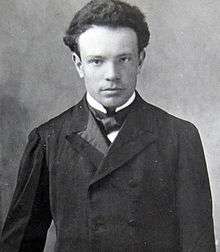Lucrezia (opera)
| Ottorino Respighi |
|---|
 |
|
Operas
|
Lucrezia is an opera in one act and three tableaux by Ottorino Respighi to a libretto by Claudio Guastalla, after Livy and William Shakespeare's The Rape of Lucrece. Respighi died before finishing the work, which was therefore completed by the wife of the composer, Elsa Respighi, and by one of his pupils, Ennio Porrino. Lucrezia premiered on 24 February 1937 at the Teatro alla Scala in Milan, in a production directed by Mario Frigerio with sets designed by Pietro Aschieri.[1] The première had a good reception.[2]
Lucrezia was much appreciated by the famous Italian musicologist Andrea Della Corte, who considered this opera as one of the best stage works of Respighi, thanks to the accomplished balance of expressivity and musical skill.[2] One of the distinctive features of Lucrezia is the presence of the Voice, a character that sings from within the orchestra and describes what is happening on the stage and the emotions of the other characters.
Roles
| Role | Voice type | Premiere Cast, February 24, 1937 (Conductor: Gino Marinuzzi)[1] |
|---|---|---|
| The Voice | mezzo-soprano | Ebe Stignani |
| Lucrezia | soprano | Maria Caniglia |
| Servia | mezzo-soprano | Maria Marcucci |
| Venilia | soprano | Renata Villani |
| Collatino | tenor | Pablo Civil |
| Bruto | tenor | Ettore Parmeggiani |
| Sesto Tarquinio | baritone | Gaetano Viviani |
| Tito | baritone | Leone Paci |
| Arunte | baritone | Eraldo Coda |
| Spurio Lucrezio | bass | Bruno Carmassi |
| Valerio | bass | Aristide Baracchi |
Instrumentation
Lucrezia is scored for the following instruments:[3]
piccolo, 2 flutes , 2 oboes, English horn, 2 clarinets in B flat, 2 bassoons, 4 horns in F, 3 trumpets in B flat, 2 tenor trombones, bass trombone, tuba, cymbals, bass drum, tam-tam, strings.
Synopsis
- Time: 509 BC.
- Place: Rome
Sesto Tarquinio (son of Tarquin the Proud, the last king of Rome), Bruto and Collatino are in the tent of Tarquinio and discuss about the faithfulness of their wives; Bruto seems the most sceptical. Later they decide to return to Rome and verify directly the uprightness of their women.
Lucrezia, the wife of Collatino, tells her women a story that highlights the importance of living with honour and honesty. But during the night Tarquinio, who has become infatuated with Lucrezia, gets into the house of Collatino and rapes her.
The following day Lucrezia, overwhelmed with shame, asks Collatino to be revenged, then takes her own life. Bruto becomes one of the leaders of the rebellion against Tarquinio and his father, that leads to the overthrow of the monarchy.
Recordings
1958: Oliviero De Fabritiis, Orchestra sinfonica e Coro di Milano della RAI, LP Golden Age of Opera EJS 535[4] | |
|---|---|
The Voice: Miti Truccato Pace |
Tarquinio: Mario Sereni |
1981: Ettore Gracis, Junge Philarmonie der A.M.O.R, CD Bongiovanni, Cat. GB 2013-2[5] | |
The Voice: Jone Jon |
Tarquinio: Daniel Washington |
1994: Adriano, Slovak Radio Symphony Orchestra (Bratislava), CD Marco Polo, Cat. 223717[6] | |
The Voice: Stefania Kaluza |
Tarquinio: Richard Haan |
References
Notes
- 1 2 "Première of Lucrezia". amadeusonline (in Italian). Retrieved 31 December 2014. External link in
|website=(help) - 1 2 "La prima di Lucrezia, opera postuma di Respighi". La Stampa (in Italian). Torino. 25 February 1937. Retrieved 30 December 2014.
- ↑ "Ottorino RESPIGHI. Catalogo delle composizioni suddiviso per generi musicali: Opere liriche". l'Orchestra Virtuale del Flaminio (in Italian). Retrieved 30 December 2014. External link in
|website=(help) - ↑ "Fernando Corena Discography: Lucrezia". Retrieved 31 December 2014.
- ↑ MusicWeb International
- ↑ "Ottorino Respighi - Lucrezia - Adriano (1994)". Operaclass. Retrieved 30 December 2014. External link in
|publisher=(help)
Sources
- Bernardoni, Virgilio (1996). "Lucrezia". In Gelli, Piero. Dizionario dell'opera (in Italian). Milano: Baldini&Castoldi. ISBN 88-8089-177-4.
External links
- Pentith, Sybil. "LUCREZIA - The story of Respighi's last opera". MusicWeb International. Retrieved 30 December 2014. External link in
|publisher=(help)